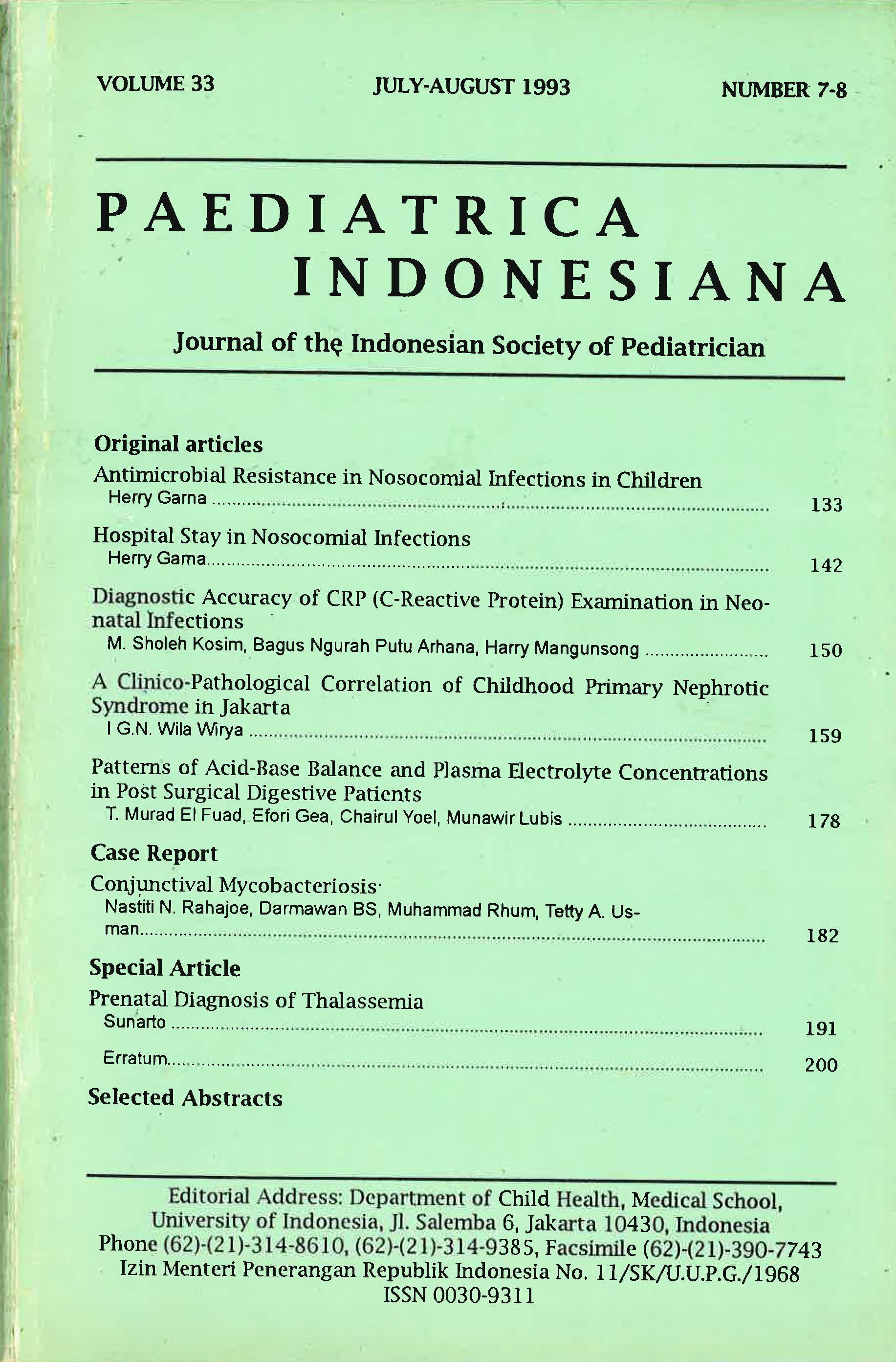Patterns of Acid Base Balance and Plasma Electrolyte Concentrations in Post Surgical Digestive Patients
Abstract
Patterns of acid-base balance and plasma electrolyte concentrations of postsurgical digestive patients were studied retrospectively. The patients were treated at the Pediatric ICU Dr. Pirngadi Hospital, Medan, during the period of February 1991 through January 31 1992. There were 131 patients admitted to the Pediatric ICU, 67 (51.1 %) of them had had gastrointestinal surgery. Arterial blood gas and I or plasma electrolyte examinations were done in 92% of patients within 12 hours of admission. In 50 patients both blood gas and electrolyte concentration values were examined; 6 of them died. One out of 14 patients who had only serum electrolyte concentration values died. One out of 3 patients who had neither blood gas nor plasma electrolyte concentration values died. Acid-base imbalances were found in 66% of those 50 patients, consisting of 28% metabolic acidosis, 12% respiratory alkalosis, 8% respiratory acidosis, and 6% metabolic alkalosis. Hyponatremia was found in 68.4% of the survivors and in 2 out of 6 patients who died. No hypernatremia was found in any of the patients. Hypokalemia was found in 24.6% of patients survived; and none in those who died. Hyperkalemia was encountered in 24.6% of those who survived. The overall mortality of patients who had undergone gastrointestinal surgery in the Pediatric ICU, Pirngadi Hospital, was 8/67 (11.9%).
References
2. Burrell L Zeb Jr, Burrell OL. Fluid electrolyte and Pediatric decision making. Philadelphia: BC acid base problems. In Critical care; 3rd ed; St. Decker Inc; 1985: 82-3.Stephan Behrman ed; Louis, C.V. Mosby; 1977; 270-88.
3. Corral JH. Disturbances in acid base balance. In name editor Water, electrolyte, and acid base metabolism; Diagnosis and management. 2nd ed Philadelphia; editor JB Lippincott, 1989; 206-86.
4. Falkner B, Gazdicc MA. Fluid and electrolyte; In Sol S Zimmerman; Philadelphia, W8 Saunders; 1985; 55-61 .
5. Hansen R. Hyponatremia; in Don H (Ed) Decision making in critical care. BC Decker. Inc; Toronto; 1985; 154-5.
6. Kappy MS. Hyperkalemia; in Behrman s (Ed) Pediatric decision making. Philadelphia: BC Decker Inc; Philadelphia; 1985; 82-3.
7. Lindenfeld SM. Hyperkalemia; in Don H (Ed) in critical care. Toronto: BC Decker Inc, 1985; 156-7.
8. Swenson. Fluid and electrolyte in pediatric surgery, Jhon G. Raffensperger ed; Fifth Ed; Appleton & Lange 1990; 73-9.
Copyright (c) 2019 T. Murad El Fuad, Efori Gea, Chaerul Yael, Munar Lubis

This work is licensed under a Creative Commons Attribution-NonCommercial-ShareAlike 4.0 International License.
Authors who publish with this journal agree to the following terms:
Authors retain copyright and grant the journal right of first publication with the work simultaneously licensed under a Creative Commons Attribution License that allows others to share the work with an acknowledgement of the work's authorship and initial publication in this journal.
Authors are able to enter into separate, additional contractual arrangements for the non-exclusive distribution of the journal's published version of the work (e.g., post it to an institutional repository or publish it in a book), with an acknowledgement of its initial publication in this journal.
Published 2019-01-24













